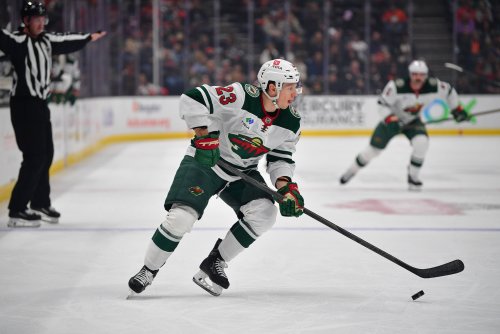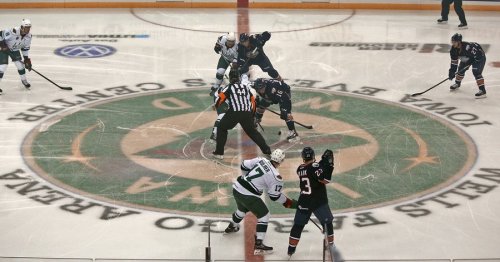
Last week, I wrote a post about some of the Minnesota Wild’s underlying metrics, such as CF%, ScF%, GF%, xGF% and PDO. As you might have guessed, the Wild’s CF% is mediocre and its PDO is high, but the Wild’s ScF%, GF% and xGF% are really high too. And we speculated that that might be a result of the Wild allowing fewer shots compared to other NHL teams in the areas of the ice where NHL teams typically score goals.
At the end of that post, I suggested that this week I would investigate whether the Wild’s play should be expected to repeat this regular season success in the playoffs. What I didn’t realize at the time was that there had already been a Fan Post published that looked at the exact same thing. WildEast covered this same territory a few days before my post and I encourage you to go and read it if you missed it like I did. WildEast found the same results that I found this week in poking through the numbers on Corsica.hockey. WildEast even linked to the same story with the same graphics to which I was going to link from a 2013 article from Chris Boyle available here. Some cool charts.
In any event, like WildEast, I didn’t find that teams tended to succeed in the playoffs with strong percentages related to ScF% or xGF% and WildEast did a good job of spelling that out. I would like to point out, however, that the top two teams in ScF% and xGF% last season were Pittsburgh and San Jose and those two teams played a meaningful series toward the end of the playoff season. The beginning of a trend!
So, I went looking for another topic to write about and started poking around with stats.hockeyanalysis.com. This article was written on Wednesday before and during the Wild/Blackhawks tilt, so the stats are through Tuesday. I looked at all forwards who have played at least 300 minutes at 5v5 this season. That’s an even total of 360 forwards, so about 12 per team. And then sorted by PDO.
Hello Minnesota and Washington! Look at that! Six from the Wild and eight from the Caps in the top 15! The only interloper in that list is Grabner at 12.
So, this isn’t going to be a typical story about regression. For one, the Hockey Wilderness has had plenty of pieces on the topic and they’ve been well done. And two, we’re in February, almost two-thirds of the way through the season. There isn’t a lot of time left to regress. I would rather take a look at individual performance this season.
We all know by now that PDO is calculated by adding team shooting percentage and save percentage when the player is on the ice. For PDO to decrease, shooting percentage, save percentage or both need to come down to settle around 100, where most players end up by the end of the season. Dubnyk and Holtby together pace the league among starting goaltenders in overall save percentage and save percentage at 5v5. That’s not going to change significantly.
Instead, I would suggest any team-wide regression we might see in the Wild over the remainder of the regular season is likely to come from Wild forwards who have been shooting over their heads this season and I think that graphic points us in the right direction. That conversation starts with Mikko Koivu. The Wild are shooting 11% with Mikko on the ice this season, which is zoomed by the fact that Koivu’s personal shooting percentage is 18.3% with 11 5v5 goals on 60 shots. That’s just crazy and I’ve written about Koivu recently, but Mikko shot 4% last season with four 5v5 goals on 97 shots. In 10 seasons, Koivu’s highest shooting percentage was 9.5% and he’s generally come in around 8%. Mikko’s been living right this season, but we shouldn’t expect that shooting percentage to sustain.
The other two players that stick out on that list are Christ Stewart and Tyler Graovac, two players that play mostly on the fourth line. Stewart leads the team with a personal shooting percentage of 21% with 11 5v5 goals on 51 shots. Stewart’s an offensive player with defensive shortcomings who has posted shooting percentages ranging from 7-13%. Stewart has shown that he can shoot the puck, but his shooting percentage is likely to come down similar to Koivu. And Battery shooting at 16% with six goals on 36 shots is great depth scoring. He doesn’t have a track record, but I don’t think anyone expects that shooting percentage to last. Finally, Jordan Schroeder hasn’t reached 300 minutes, so he isn’t on the list above. But he’s fourth on the team behind Stewart, Koivu and Graovac on the Wild with a 15% shooting percentage with three goals on 20 shots in 193 minutes at 5v5 this season.
Nobody thinks that the best four shooting forwards on the team are Stewart, Koivu, Graovac and Schroeder, obviously. It’s been nice boost.
But what about the other three players on the list above: Jason Zucker, Mikael Granlund and Nino Niederreiter?
Well, Nino’s still just a boss. He’s shooting 11% on 10 goals on 90 shots at 5v5. He’s shot 11% the past two seasons, so he is right where he has been in the past. There’s no regression here.
And Granlund and Zucker have benefitted from skating alongside Koivu for much of this season. But their overall shooting percentage doesn’t diverge much from what they have done in the past. Granlund’s shooting percentage is only 9% on eight goals on 90 shots. And that doesn’t diverge much from his career so far, which shows a shooting percentage ranging from five to 10 percent. Zucker’s shooting percentage is at 14%. Zucker’s shooting percentage was only 8% last season, but he was at 15% the year before and 12% two years prior.
The notable contrast is that the last 30-goal scorers for the Wild haven’t even been mentioned. Parise is sitting at 6%, which is the lowest he’s been. And Pominville’s shooting percentage is at 9%, twice the 4% he posted last season. Even though they are on the third line now, will Pominville and Parise make up the difference from the 4th lines shooting percentage over the next 30 games? I think they might.
Conclusion, whether it’s better coaching or the natural progression of the Wild’s young wingers, but I don’t see a great drop off over the second third of the season.
Think you could write a story like this? Hockey Wilderness wants you to develop your voice, find an audience, and we'll pay you to do it. Just fill out this form.









Recommended Comments
There are no comments to display.
Join the conversation
You can post now and register later. If you have an account, sign in now to post with your account.
Note: Your post will require moderator approval before it will be visible.